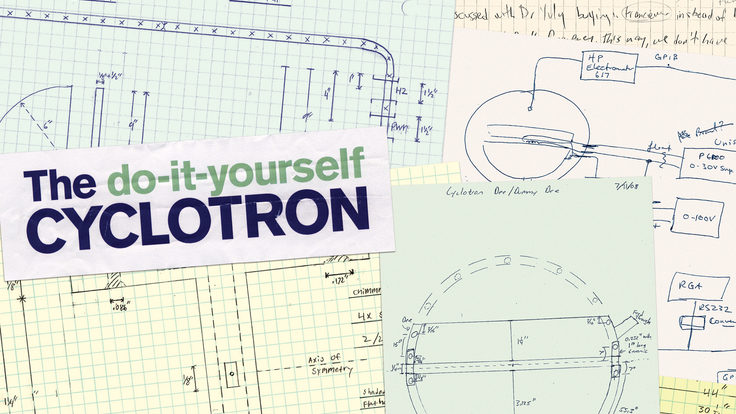At least when it comes to particle accelerators, bigger is usually better. The bigger the particle accelerator, the more energetic its particle collisions; the more energetic the collision, the greater the variety of particles produced.
Before CERN’s Large Hadron Collider, the world’s most powerful accelerator was the Tevatron, a circular collider 4 miles long. Scientists used it to discover the last and most massive of the quarks, the top quark. To discover the Higgs boson, the LHC had to be larger still—almost 17 miles around. Scientists are discussing ideas for even bigger accelerators, such as the proposed Future Circular Collider, which would have a colossal circumference of more than 62 miles.
Bigger colliders (and the bigger price tags that come with them) have been essential for advances in particle physics. But what if there were a way to scale down their immense size? What if you could accelerate particles to even higher energies in only a few meters?
This is the alluring potential of an up-and-coming technology called plasma wakefield acceleration.
Let’s break down the name. “Plasma” is often referred to as the “fourth state of matter.” It’s created when atoms in a gas are stripped of their electrons, often via a laser. This mixture of ions and free floating electrons behaves like a gas, except that it’s extremely sensitive to electric and magnetic fields.
A “wake” is created when something is quickly pushed through a fluid or gaseous substance, like a boat cutting through water. In this case, the substance is plasma.
And “acceleration” simply refers to the effect: When a bunch of particles is placed behind a plasma wake, it accelerates, like a wake surfer.
There are a variety of ways to create plasma wakefield acceleration, or PWFA. Generally, these can be broken down into “laser wakefield acceleration” and “beam wakefield acceleration.” Both rely on plasma as a medium, but to “drive” the wake, one technique uses lasers while the other uses a beam of particles. Current efforts using this beam technique rely on electrons, protons, or positrons.
This month, PWFA turns 40. The concept was developed in an audacious 1979 paper by scientists Toshiki Tajima and John Dawson, both then at the University of California, Los Angeles. Today, several hundred physicists at institutes around the world study PWFA.
In the past few years, advances in the field have turned heads in the larger physics community. Studies have corroborated the technique’s ability to accelerate particles and increased its prospects of practical application. But even if PWFA is as promising as its proponents claim, it will be years if not decades before it begins to succeed traditional accelerating technology.
RF cavities vs. PWFAs
Conventional accelerators rely on hollow metal chambers called radio-frequency cavities, or RF cavities. An electric field inside an RF cavity accelerates particles that pass through it.
“In simple terms, it works like a battery,” says Edda Gschwendtner, a particle physicist who heads the AWAKE plasma wakefield accelerator R&D collaboration at CERN. “You have a positive end and a negative end, and then particles … are attracted by the field and get accelerated.”
This technology is extremely reliable, and used in the nearly 30,000 accelerators around the world. For decades, improvements to the design of RF cavities and larger machines using more and more of them allowed accelerator energy to double about every six years. Recently, however, this trend has been leveling off.
That’s because RF cavities can sustain electric fields only up to a certain strength—too high and the metal can ionize, releasing electrons that contaminate the vacuum inside the cavities, destroying the RF field inside the cavity.
Today’s cavities have an acceleration gradient, or increase in energy, of about 10 MeV—10 million electronvolts—per meter. Proposed colliders like the International Linear Collider aim to investigate physics at the Higgs scale—around 125 GeV. To reach that energy, electrons and positrons would each have to travel through about 8 miles of cavities. Unless the accelerating technology improves, machines will have to get larger and larger to reach higher energies where physics beyond the Standard Model may be hidden.
PWFA has the potential to blow these numbers away.
When he gives talks, physicist Spencer Gessner of the AWAKE team likes to give people an idea of how potent plasma is. “The air in the room that we're breathing has a particle density of 2.7x1019 particles per cubic centimeter,” Gessner says.
So what? Well, if you plug that density into an equation that tells you how much acceleration a plasma can support, you get a big number. A really big number, one that puts highly engineered, state-of-the art RF cavities to shame: 500 GeV per meter. That’s enough force to produce a Higgs boson in an accelerator the size of a shoe box.
“We just have to kind of light the air on fire and then drive a wake in that, and you have something a thousand times higher gradient than these finely engineered devices,” Gessner says. It’s a simplification of the process, but his point is clear: Plasma has potential.
“The beauty of plasma is that it’s basically giving you this enormous acceleration gradient,” Gessner says. “Of course, the complication is harnessing that.”
And it is certainly easier said than done. The basic principle, though, is easy enough to grasp.
“Imagine you have a boat which crosses a lake,” Gschwendtner says. “In our case the lake is the plasma, and the boat is what we call the ‘drive beam.’ The drive beam goes into the lake and creates waves, and these are the wakefields.”
Behind the drive beam sits a “trailing beam,” which in this analogy is like a wake surfer, riding behind a wake.
“Now what you do is sit electrons onto these wakes, and then they get accelerated,” Gschwendtner says. Why? Wake surfers accelerate because they effectively ride down a watery hill; they’re pulled along by gravity. Electrons or other particles accelerate because they’re pulled by an electric field.
How do you create an electric field? Plasma is what’s known as “quasi-neutral.” As a whole, the positive charges of its ions are canceled out by the negative charges of its electrons. But these free-floating electrons are easily pushed around, and a difference smaller than 1 percent in electron density can create a sizable electric field.
The strength of the electric field is proportional to the square root of the density; as plasma gets denser, the field can get a bit stronger. A stronger electric field creates more acceleration.
But how you get that acceleration depends on the type of boat you use.
Laser wakefield acceleration
All PWFA experiments require lasers to create a plasma—that’s how they ionize gas. But laser wakefield accelerators also use a laser as a drive beam. The radiation pressure from the laser pushes electrons out of the way. Ions, which are much heavier, remain essentially motionless, while bubbles of electron-free areas propagate forward through the plasma.
This difference in electron density creates an electric field that accelerates particles placed precisely at the back of a bubble.
Beam wakefield acceleration
Beam wakefield acceleration techniques use a beam of particles as a drive beam instead of a laser. Though they’re called “beams,” particle beams aren’t continuous and long like lasers, but instead are short bursts of particles fired in a straight line.
Plasma wakefield acceleration using electrons
Using a beam of electrons as the drive beam is similar to using a laser. A bundle of electrons is fired into the plasma; this time it pushes aside other electrons because they are both negatively charged. Again, the ions remain in place so that a positively charged bubble is formed. Particles at the back of the bubble are accelerated because of a strong electric field created by differences in electron density.
Plasma wakefield acceleration using positrons
Ideally, physicists would like to be able to use plasma wakefield acceleration to accelerate both electrons and positrons. Because both are fundamental units of matter and matter-antimatter partners, they annihilate cleanly on contact. Compared to the proton-proton collisions of the LHC, electron-positron collisions are incredibly clean and easy to interpret.
Unfortunately, positrons are trickier to work with. When a bunch of positrons are fired through plasma, they suck in electrons instead of expelling them. Sucking in electrons also creates a similar bubble of mostly electron-free space, but it doesn’t stay electron-free for long—electrons rush down the center to catch up with the positrons. With electrons in the center of the bubble, the electric field can get defocused, so that positrons aren’t accelerated uniformly forward. Physicists have put forward possible solutions that rely on lasers to shape the plasma so that the defocusing effect is mitigated.
Still, physicists have had some success with positrons, accelerating them to 5000 MeV in about a meter.
Plasma wakefield acceleration using protons
Like positrons, protons have a positive charge, which makes them tricky to work with, because they don’t create completely electron-free bubbles. So why work with them? Their energy.
“The way we accelerate is that we take energy from whatever beam we put in. We give it to the plasma, and the plasma gives it to the charge that we accelerate,” says Diana Amorim, a physicist at Stony Brook University.
While a bunch of electrons or a laser might hit the plasma with 60 joules of energy, a more massive bunch of protons can have 20,000 joules. Here, it’s again helpful to use the boat and wake surfer analogy.
“A laser beam or electron beam has little petrol stored. So in these beams, the boat stops on the lake. You cannot accelerate particles for a very long distance,” Gschwendtner says.
Each joule is about 6 trillion MeV, but most of the energy is inefficiently lost. If scientists could extract the massive energy stored in the bunches of protons, their boat could go for dozens of meters, allowing the particles in their wake to accelerate all along the way.
Last year, AWAKE successfully used a drive beam of protons to accelerate electrons to 2000 MeV.
| Type of acceleration | Experiments |
|---|---|
| Laser wakefield acceleration | BELLA, TREX, CLF, LUX |
| Plasma wakefield acceleration using electrons |
FACET, FACET II, DESY FLASHForward |
| Plasma wakefield acceleration using positrons |
FACET, FACET II |
| Plasma wakefield acceleration using protons |
AWAKE |
Future questions
Each of these PWFA techniques has pros and cons, but they’re all still in development and all need to answer one question, Gessner says: Can you have high efficiency, high quality acceleration at the same time?
High efficiency means that particles in the wake actually get the energy from the drive beam, so it’s not wasted. High quality refers to features of a beam, like the energy spread among the particles in a beam—physicists want all of their accelerated particles to have about the same energy.
Physicists at FACET accelerator facility at SLAC National Accelerator Laboratory, for example, have already created high efficiency, low quality beams. But getting both features is tricky, because higher energy beams want to misbehave more—they’re more likely to wiggle up or down instead of simply going straight.
To someday replace existing accelerator technology, achieving both is a must for PWFA.
With experiments at DESY in Germany, CERN in France and Switzerland, and SLAC, Argonne National Laboratory and Lawrence Berkeley National Laboratory in the United States, physicists studying PWFA are confident they’ll continue to take steps toward that goal the next few years.
“It was easy for the community to be skeptical when you have not shown any results,” Gschwendtner says. “Of course, they are now more convinced because we've shown these results.”
“The amazing thing about plasma accelerators is that the naysayers have been coming up with why things wouldn't work at every stage of the program,” says Chan Joshi, a particle physicist at UCLA who helped found the field of PWFA.
In the beginning, he says, naysayers doubted plasma accelerator researchers could reach the high gradient they predicted they could reach, a thousand times larger than the conventional cavity.
“Well that turned out to be not the case,” he says.
After that, the doubters thought plasma accelerator researchers would never achieve a narrow-energy-spread beam.
“Well that turned out not to be the case,” he says.
Challenges remain, but scientists around the world continue to push the technology forward in the hopes of showing that, while bigger has historically been better, in the future smaller can be best.













